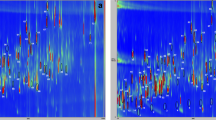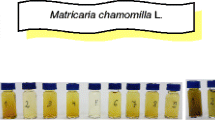Abstract
A multiresidue analytical method is described for pesticides, transformation products, and related toxicants based upon high performance liquid Chromatographic (HPLC) fractionation of extracted residue on a Partisil® silica gel normal phase column followed by selective-detector gas chromatographic (GC) determination of components in each fraction. The HPLC mobile phase gradient (hexane to methylt-butyl ether) gave good Chromatographic efficiency, resolution, reproducibility and recovery for 61 test compounds, and allowed for collection in four fractions spanning polarities from low polarity organochlorine compounds (fraction 1) to polarN-methylcarbamates and organophosphorus oxons (fraction 4). The multiresidue method was developed for use with air samples collected on XAD-4® and related trapping agents, and water samples extracted with methylene chloride. Detection limits estimated from spiking experiments were generally 0.3–1 ng/m3 for high-volume air samples, and 0.01–0.1 μg/L for one-liter water samples. Applications were made to determination of pesticides in fogwater and air samples.
Similar content being viewed by others
References
Ambrus A, Lantos J, Visi E, Csatlos I, Sarvari L (1981) General method for determination of pesticide residues in samples of plant origin, soil and water. I. Extraction and cleanup. II. Thin layer Chromatographic determination. III. Gas chromato graphic analysis and confirmation. J Assoc Offic Anal Chem 64:733–768
Ambrus A, Thier HP (1986) Application of multiresidue procedures in pesticide residue analysis. Pure and Applied Chem 58:1035–1062
Burke JA (1971) Development of the Food and Drug Administration's method of analysis for multiple residues of organochlorines in food and feeds. Residue Reviews 34:59–90
Crowley RT, Siggia S, Uden PC (1980) Class separation and characterization of shale oil by liquid chromatography and capillary column gas chromatography. Anal Chem 52:1224–1228
Ferreira GA (1979) Volatilization and Other Loss Routes forN-Methylcarbamate Insecticides Systemically Applied to Rice Plants. Ph.D. Thesis. University of California, Davis, CA, 163 PP
Glotfelty DE, Sciber JN, Liljedahl LA (1987) Pesticides in fog. Nature 325:602–605
Hermann BW, Sciber JN (1981a) Glass capillary gas chromatography of pesticides. In: Jennings WG (ed) Applications of Glass Capillary Gas Chromatography. Marcel Dekker, NY, pp 175–202
— (1981b) Sampling and determination of S,S,S-tributyl phos-phorotrithioate, dibutyl disulfide, and butyl mercaptan in field air, Anal Chem 53:1077–1082
Hopper ML (1981) Gel permeation system for removal of fats during analyses of foods for residues of pesticides and herbicides. J Assoc Offic Anal Chem 64:720–25
Jennings WG (1977) Volatile components of figs. J Food Chem 2:185–191
Johansson CE (1978) A multiresidue analytical method for determining organochlorine, organophosphorus, dinitrophenyl, and carbamate pesticides in apples. Pesticide Sci 9:313–322
Luke MA, Froberg JE, Masumoto HT (1975) Extraction and cleanup of organochlorine, organophosphate, organonitrogen, and hydrocarbon pesticides in produce for determination by gas-liquid chromatography. J Assoc Offic Anal Chem 58:1020–1026
Marble LK, Delfino JJ (1988) Extraction and solid phase cleanup methods for pesticides in sediment and fish. American Laboratory, November, 23–32
Mast TJ, Hsieh DPH, Sciber JN (1984) Mutagenicity and chemical characterization of organic constituents in rice straw smoke paniculate matter. Environ Sci Technol 18:338–343
McMahon BM, Burke JA (1978) Analytical behavior data for chemicals determined using the AOAC multiresidue methodology for pesticide residues in foods. J Assoc Offic Anal Chem 61:640
— (1987) Expanding and tracking the capabilities of pesticide multiresidue methodology used in Food and Drug Administration's pesticide monitoring program. J Assoc Offic Anal Chem 20:1072–1081
Moye HA (1981) High performance liquid Chromatographic analysis of pesticide residues. In: Moye HA (ed) Analysis of Pesticide Residues. John Wiley and Sons, NY, pp 157–197
Sciber JN, Ferreira GA, Hermann B, Woodrow JE, (1980) Analysis of pesticide residues in the air near agricultural treatment sites. In: Harvey Jr. J, Zweig G (eds) Pesticide Analytical Methodology. ACS Symposium Series 136, Washington, DC
Sciber JN, Lee SM, McChesney MM, Watson TR, Nelson CJ, and Brower LP (1985) New cardiac glycosides (cardenolides) from Asclepias species. In: Seawright AA et al. (eds) Proceedings of the Australia-U.S.A. Poisonous Plants Symposium-Plant Toxicology, pp 427–437
Sciber JN, McChesney MM, Kon R, Leavitt RA (1984) Analysis of glyphosate residues in kiwi fruit and asparagus using high-performance liquid chromatography of derivatized glyphosate as a cleanup step. J Agric Food Chem 32:678–681
Sherma J, Shafik TM (1975) A multiclass, multiresidue analytical method for determining pesticide residues in air. Arch Environ Contam Toxicol 3:55–71
Stalling DL, Smith LM, Petty JD (1979) Approaches to comprehensive analyses of persistent halogenated environmental contaminants. In: Van Hall CE (ed) Measurement of Organic Pollutants in Water, ASTM STP 686, American Society for Testing Materials, Washington DC, pp 302–323
Thompson JF, Reid SJ, Kantor EJ (1977) A multiclass, multiresidue analytical method for pesticides in water. Arch Environ Contam Toxicol 6:143–157
Wehner TA, Woodrow JE, Kim Y-H, Sciber JN (1984) Multiresidue analysis of trace organic pesticides in air. In: Keith LH (ed) Identification and Analysis of Organic Pollutants in Air, Butterworth Publishers, Woburn, MA, pp 273–290
Woodrow JE, Majewski MS, Sciber JN (1986) Accumulative sampling of trace pesticides and other organics in surface water using XAD-4 resin. J Environ Sci Health 21(2): 143–164
Author information
Authors and Affiliations
Rights and permissions
About this article
Cite this article
Seiber, J.N., Glotfelty, D.E., Lucas, A.D. et al. A multiresidue method by high performance liquid chromatography-based fractionation and gas chromatographic determination of trace levels of pesticides in air and water. Arch. Environ. Contam. Toxicol. 19, 583–592 (1990). https://doi.org/10.1007/BF01059079
Received:
Revised:
Issue Date:
DOI: https://doi.org/10.1007/BF01059079




